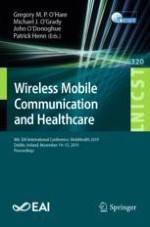2020 | Buch
Wireless Mobile Communication and Healthcare
8th EAI International Conference, MobiHealth 2019, Dublin, Ireland, November 14-15, 2019, Proceedings
herausgegeben von: Prof. Gregory M.P. O'Hare, Michael J. O'Grady, John O’Donoghue, Patrick Henn
Verlag: Springer International Publishing
Buchreihe : Lecture Notes of the Institute for Computer Sciences, Social Informatics and Telecommunications Engineering
